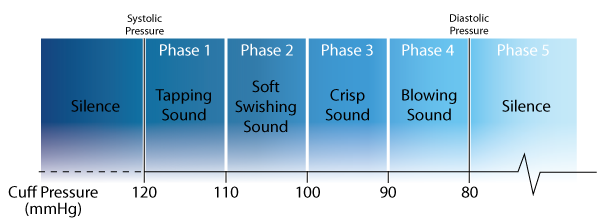- Products
- New Products
- Featured Products
- Color and Print Themes
- Blood Pressure Measurement
- NIBP / Vital Sign Monitors
- Digital Aneroid Sphygmomanometers
- Palm Aneroid Sphygmomanometers
- Pocket Aneroid Sphygmomanometers
- Pro's Combo Sphygmomanometers
- Multicuff Sphygmomanometers
- Clock Aneroid Sphygmomanometers
- Mercury Sphygmomanometers
- Home Blood Pressure Measurement
- Adcuff +
- Gauges
- Bulb & Valves
- Disposable Cuffs
- Reusable Cuffs & Bladders
- Sphygmomanometer Accessories
- Sphygmomanometer Parts
- Caseware
- CPR / Airway
- EENT
- Instruments & Accessories
- Laryngoscopes
- Penlights
- Pulse Oximeters
- Stethoscopes
- Thermometry
- Vital Signs Monitors
- Solutions
- About ADC
- Learning Center
- Support
- Blog
- Contact
9 Essential Questions about Blood Pressure – Answered

Written By:
The ADC Medical Education Team
Posted On:
May 11, 2021
Healthcare professionals know that blood pressure is one of the most important measurements in medicine. It’s often the first metric tracked when a patient visits a physician’s office or hospital. But what makes blood pressure such a vital marker in one’s overall health picture? We’ve answered nine of your most common questions here.
What is blood pressure?
With each heartbeat, blood is being pumped out into our arteries and throughout the body. Blood pressure is the force of this blood pushing against the walls of the arteries.
How is blood pressure quantified?
Blood pressure is recorded with two numbers, such as 120/80 (which is read as “120 over 80”). The top number is the systolic pressure and the bottom number is the diastolic pressure. Systolic pressure measures the pressure on the arteries as the heart contracts and pumps blood, while the diastolic pressure is the pressure on the arteries when the heart is at rest in between heartbeats. Blood pressure readings are expressed in millimeters of mercury, abbreviated as mmHg. (Mercury was the liquid traditionally used in in blood pressure gauges.)
How is blood pressure actually measured?
The brachial artery is the major blood vessel that runs through the upper arm. When a blood pressure cuff is wrapped around a patient's upper arm and inflated, the brachial artery is occluded (i.e., blood flow through the artery is stopped). As the cuff is gradually deflated, blood flow resumes. This causes a tapping or thumping sound in the artery that can be detected with a stethoscope. The first of these audible tapping sounds marks the systolic pressure. When the tapping sounds cease, that signifies the diastolic pressure.
What are Korotkoff sounds?
The tapping sounds that are heard when blood flow returns to the brachial artery are called Korotkoff sounds (or K-Sounds), named for Dr. Nikolai Korotkov, a Russian physician who discovered them in 1905. There are five phases:
K-1 (Phase 1): The appearance of the clear tapping sounds as the cuff is gradually deflated. The first is defined as the systolic pressure.
K-2 (Phase 2): The sounds in K-2 start to soften and are characterized by a swishing sound since the blood flow in the artery increases.
K-3 (Phase 3): The sounds become crisper and louder in K-3, similar to the sounds heard in K-1.
K-4 (Phase 4): As the blood flow becomes less turbulent, the sounds in K-4 are muffled and softer. Diastolic pressure is recorded at the end of Phase 4.
K-5 (Phase 5): In K-5, the sounds disappear completely since the blood flow through the artery has returned to normal.

K-3 (Phase 3): The sounds become crisper and louder in K-3, similar to the sounds heard in K-1.
K-4 (Phase 4): As the blood flow becomes less turbulent, the sounds in K-4 are muffled and softer. Diastolic pressure is recorded at the end of Phase 4.
K-5 (Phase 5): In K-5, the sounds disappear completely since the blood flow through the artery has returned to normal.

What is the auscultatory method of blood pressure measurement?
The auscultatory method is the listening technique, described above. It’s generally considered the gold standard for taking clinical blood pressure measurements. There are many variables that affect the accuracy of this method, however, so proper technique is essential. Numerous studies have shown that physicians and healthcare providers rarely follow all established guidelines (Pickering et al, 2005). For more information, see How to Take Blood Pressure.
What is the oscillometric method of blood pressure measurement?
The oscillometric method is a measuring technique based on variations in the blood pressure cuff caused by the movement of blood flow through the brachial artery. The blood pressure values are then calculated by an empirically derived algorithm. Most automated blood pressure monitors use the oscillometric method for blood pressure, since is it less susceptible to external noise.
What is mean arterial pressure (MAP)?
MAP is the average arterial pressure during a single cardiac cycle (i.e., the average blood pressure in the arteries). It’s a better measure of perfusion (the passage of fluid through the circulatory system or lymphatic system to an organ or a tissue) than the systolic measurement alone, and a good marker of both overall health and risk for developing various cardiovascular diseases. MAP is calculated as Diastolic + 1/3 (Systolic minus Diastolic).
What is hypertension?
Hypertension is another word for high blood pressure. Nearly half of American adults have high blood pressure, according to the American Heart Association. When left untreated, the damage that high blood pressure does to your circulatory system is a significant contributing factor to heart attack, stroke and other health threats.
Do I have high blood pressure?
In 2017, the American College of Cardiology and the American Heart Association released new guidelines that lowered the definition of hypertension. The new categories are:
| Normal: | Less than 120/80 mmHg |
| Elevated: | Systolic between 120-129 mmHg and diastolic less than 80 mmHg |
| Hypertension Stage 1: | Systolic between 130-139 mmHg or diastolic between 80-89 mmHg |
| Hypertension Stage 2: | Systolic at least 140 mmHg or diastolic at least 90 mmHg |
| Hypertensive Crisis: | Systolic over 180 mmHg and/or diastolic over 120 mmHg |
The changes were a way to acknowledge that complications can begin to occur at lower numbers and to allow for earlier intervention.
References:
- American College of Cardiology: “New ACC/AHA High Blood Pressure Guidelines Lower Definition of Hypertension,” https://www.acc.org/latest-in-cardiology/articles/2017/11/08/11/47/mon-5pm-bp-guideline-aha-2017
- American Heart Association: “Understanding Blood Pressure Readings,” https://www.heart.org/en/health-topics/high-blood-pressure/understanding-blood-pressure-readings
- BMJ. 2001 Apr 28; 322(7293): 1043–1047. “ABCs of Hypertension, Part II,” https://www.ncbi.nlm.nih.gov/pmc/articles/PMC1120188/
